如何用Java模擬XN*2圖靈機(jī)
對(duì)于XN*2圖靈機(jī)進(jìn)行模擬,任意給定的十進(jìn)制數(shù),轉(zhuǎn)換為收縮擴(kuò)展二進(jìn)制的編碼,再編程模擬此Turing機(jī)的運(yùn)行過(guò)程,要求輸出從開(kāi)始運(yùn)行起的每一步驟的結(jié)果。用C或C++或Java或Python語(yǔ)言實(shí)現(xiàn)程序解決問(wèn)題。
要求:1. 程序風(fēng)格良好(使用自定義注釋模板);
2. 提供友好的輸入輸出,并進(jìn)行輸入數(shù)據(jù)的正確性驗(yàn)證。
算法分析:1. 將十進(jìn)制數(shù)轉(zhuǎn)換為二進(jìn)制數(shù);
2. 將二進(jìn)制數(shù)轉(zhuǎn)換為收縮擴(kuò)展二進(jìn)制的編碼;
3. 根據(jù)當(dāng)前的內(nèi)態(tài)和輸入執(zhí)行XN*2圖靈機(jī)的指令;
4. 將結(jié)果的二進(jìn)制編碼轉(zhuǎn)換為二進(jìn)制數(shù);
5. 將二進(jìn)制數(shù)轉(zhuǎn)換為十進(jìn)制數(shù),實(shí)現(xiàn)乘2運(yùn)算功能。
概要設(shè)計(jì):算法流程圖如下:
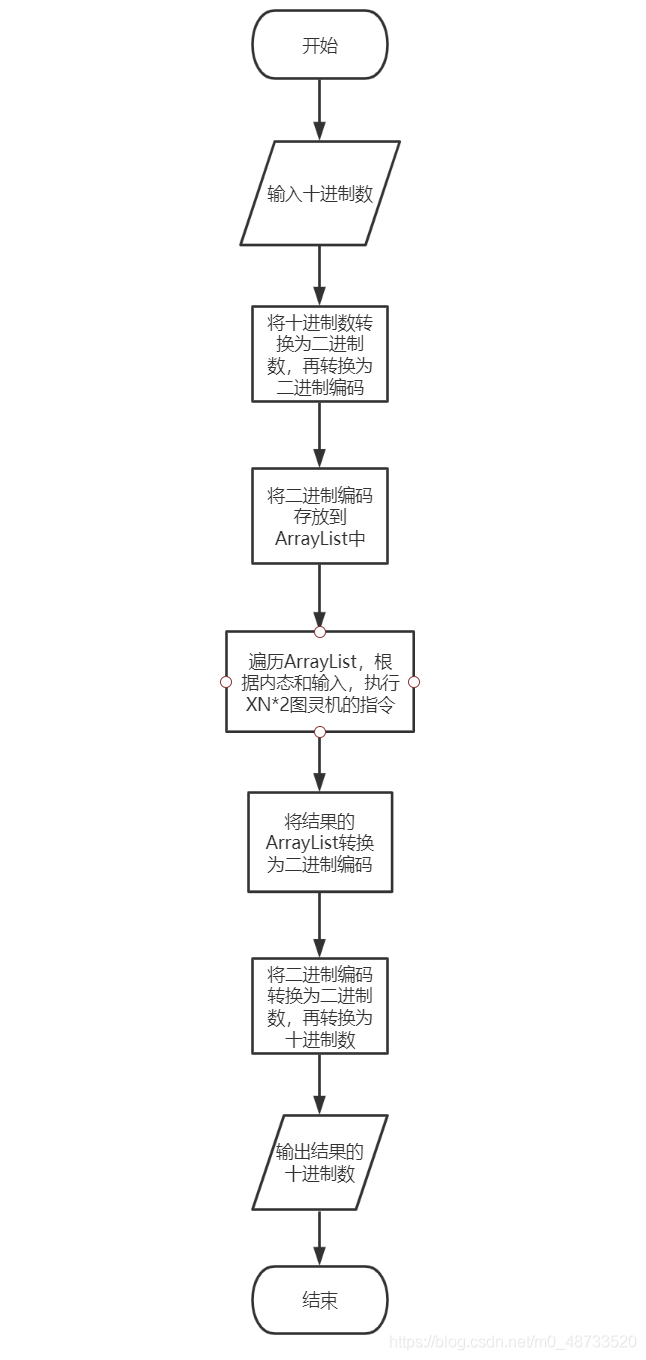
輸入的十進(jìn)制數(shù)
正確的二進(jìn)制編碼
輸出的二進(jìn)制編碼
正確的運(yùn)算結(jié)果
輸出的運(yùn)算結(jié)果
0
0011000
0011000
0
0
3
0101011000
0101011000
6
6
18
0100010011000
0100010011000
36
36
運(yùn)行結(jié)果: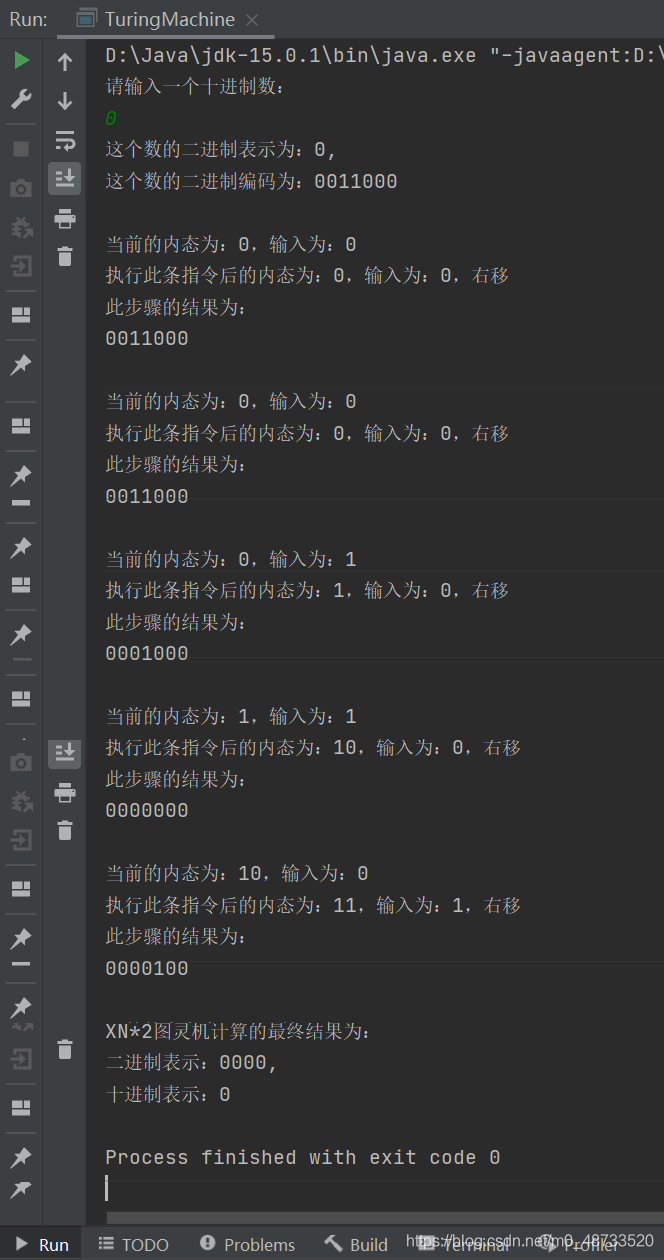
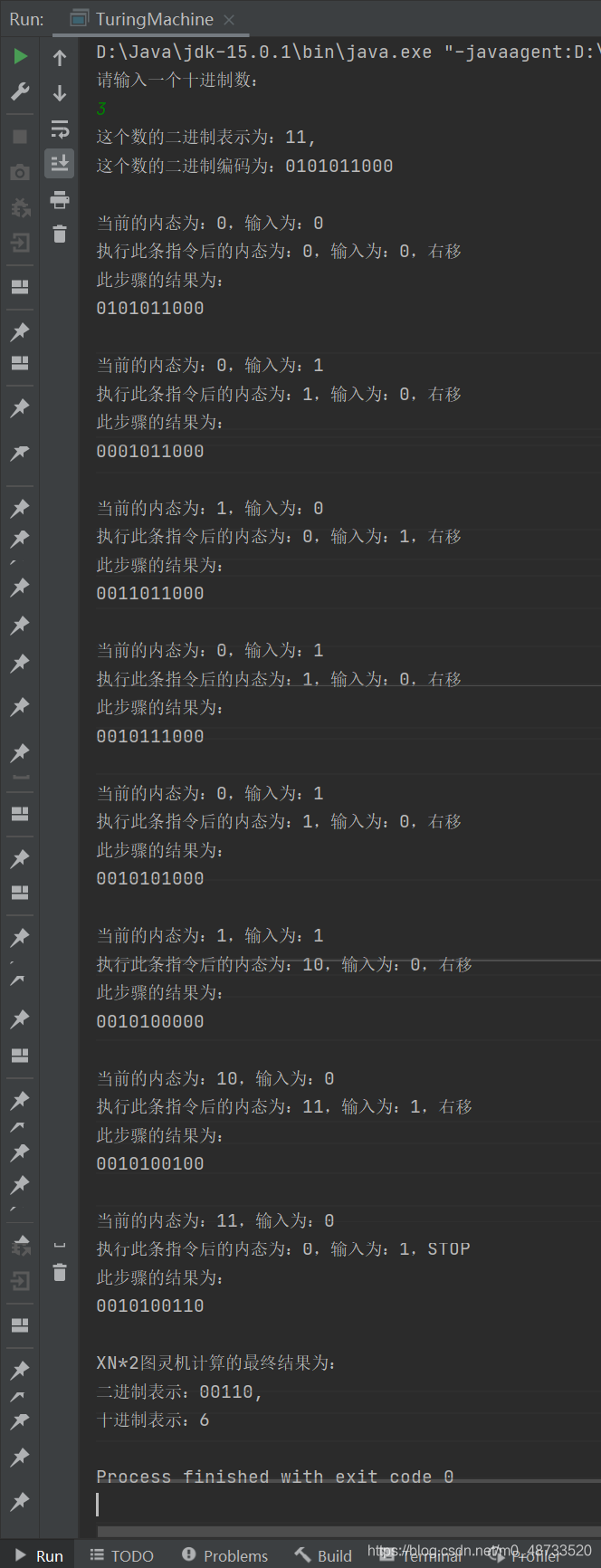

①對(duì)調(diào)用指令的方法進(jìn)行調(diào)試,開(kāi)始時(shí)binCodeList的size為0,導(dǎo)致執(zhí)行binCodeList.set(i, “0”)時(shí)出現(xiàn)錯(cuò)誤,進(jìn)過(guò)調(diào)試后發(fā)現(xiàn)是因?yàn)闆](méi)給方法設(shè)置binCodeList的參數(shù),導(dǎo)致方法中用的是類中空的binCodeList。在方法的參數(shù)中加上List<String> binCodeList就可以解決。
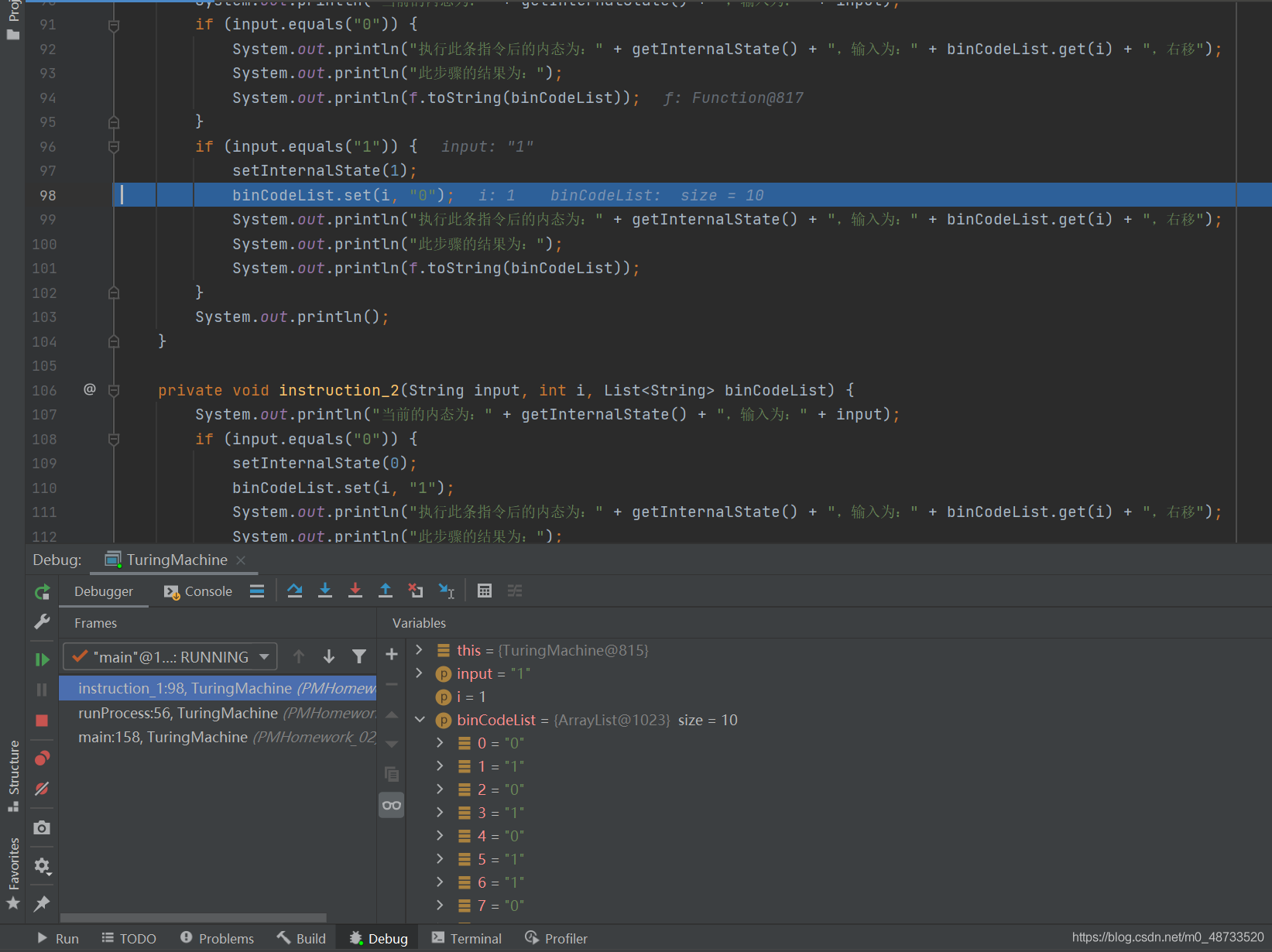
②對(duì)將二進(jìn)制編碼轉(zhuǎn)換為十進(jìn)制數(shù)的方法進(jìn)行調(diào)試,開(kāi)始時(shí)運(yùn)算結(jié)果出現(xiàn)錯(cuò)誤,調(diào)試后發(fā)現(xiàn)是判斷第i個(gè)字符為1,第i+1個(gè)字符為0后,沒(méi)有將i再加1,導(dǎo)致下次循環(huán)又遍歷到i+1的0,于是有些步驟結(jié)果就會(huì)多出0。在if (binCode.charAt(i + 1) == ’0’){…}代碼塊中加上i++就可以解決。
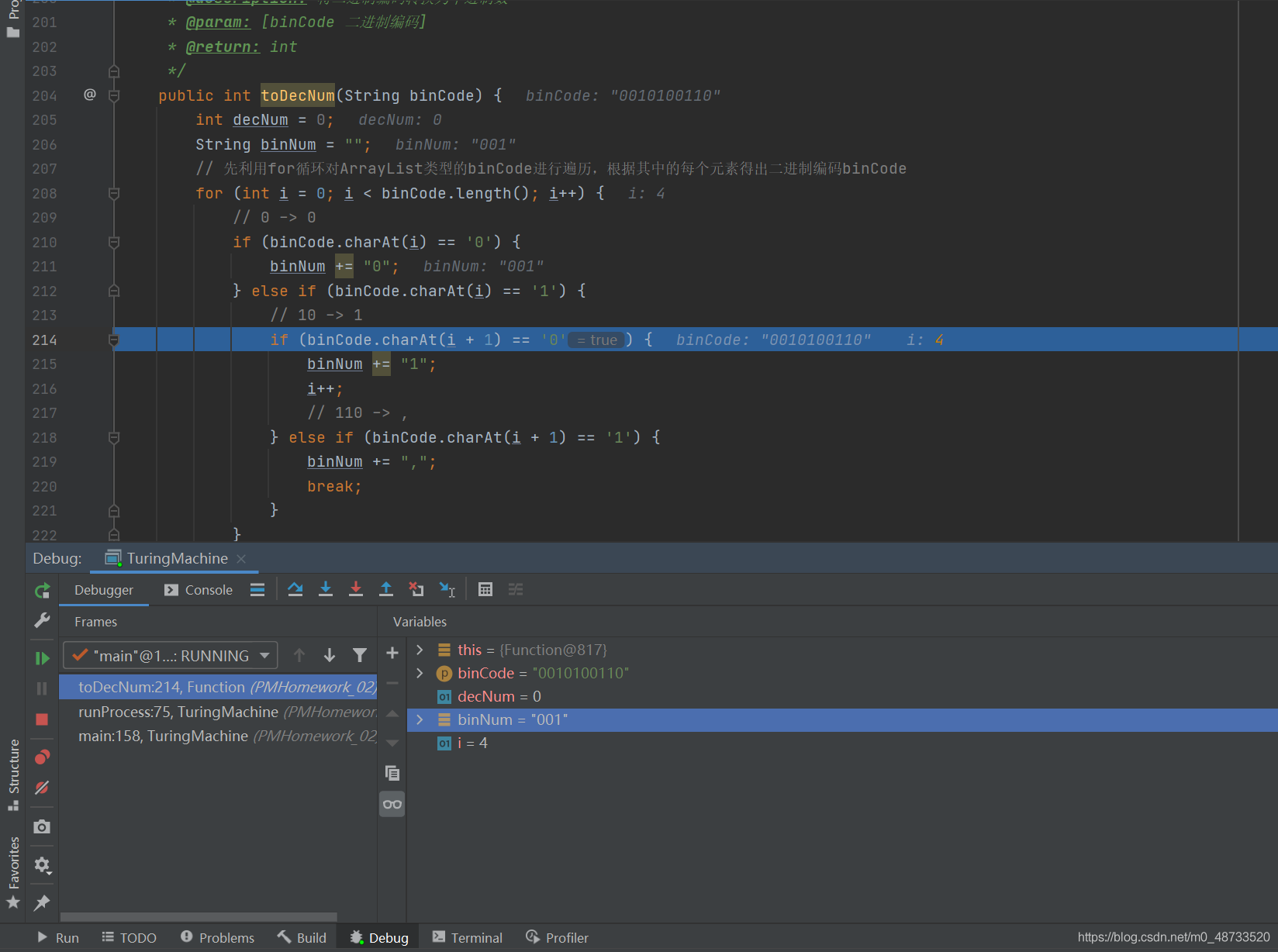
import java.util.*; /** * @description: 該類模擬XN*2圖靈機(jī),對(duì)任意給定的十進(jìn)制數(shù),轉(zhuǎn)換為收縮擴(kuò)展二進(jìn)制的編碼,并可輸出運(yùn)行中每一步驟的結(jié)果 */public class TuringMachine { private int internalState; // 圖靈機(jī)的內(nèi)態(tài) private String binCode; // 二進(jìn)制編碼 Function f = new Function(); // 需要用到的方法 List<String> binCodeList = new ArrayList<>(); // 用來(lái)存放二進(jìn)制編碼 static int r = 0; // 當(dāng)r為1時(shí)機(jī)器向右移動(dòng)一格 static int s = 0; // 當(dāng)s為1時(shí)機(jī)器停止運(yùn)行 TuringMachine() {internalState = 0;binCode = '0'; } public int getInternalState() {return internalState; } public void setInternalState(int internalState) {this.internalState = internalState; } public String getBinCode() {return binCode; } public void setBinCode(String binCode) {this.binCode = binCode; } /** * @description: 模擬圖靈機(jī)的運(yùn)行過(guò)程 * @param: [binCode 二進(jìn)制編碼] * @return: void */ public void runProcess(String binCode) {binCodeList = f.toArrayList(binCode); // 將二進(jìn)制碼binCode轉(zhuǎn)換為ArrayList類型存放在binCodeList中// for循環(huán)對(duì)binCodeList進(jìn)行遍歷,根據(jù)當(dāng)前內(nèi)態(tài)的值判斷該執(zhí)行哪條指令for (int i = 0; i < binCodeList.size(); i++) { r = 1; // 當(dāng)s==1時(shí)機(jī)器停止,跳出循環(huán) if (s == 1) {break; } switch (getInternalState()) {// 內(nèi)態(tài)為0時(shí)執(zhí)行指令1case 0: instruction_1(binCodeList.get(i), i, binCodeList); break;// 內(nèi)態(tài)為1時(shí)執(zhí)行指令2case 1: instruction_2(binCodeList.get(i), i, binCodeList); break;// 內(nèi)態(tài)為10時(shí)執(zhí)行指令3case 10: instruction_3(binCodeList.get(i), i, binCodeList); break;// 內(nèi)態(tài)為11時(shí)執(zhí)行指令4case 11: instruction_4(binCodeList.get(i), i, binCodeList); break;default: break; }}System.out.println('XN*2圖靈機(jī)計(jì)算的最終結(jié)果為:');f.toDecNum(f.toString(binCodeList)); // 將binCodeList轉(zhuǎn)換為String類型的二進(jìn)制編碼binCode,再轉(zhuǎn)換為int類型的十進(jìn)制數(shù)decNum } /** * @description: 根據(jù)指令對(duì)每一步驟結(jié)果進(jìn)行打印 * 指令1: 0 0 -> 0 0 R * 0 1 -> 1 0 R * 指令2: 1 0 -> 0 1 R * 1 1 -> 10 0 R * 指令3: 10 0 -> 11 1 R * 指令4: 11 0 -> 0 1 STOP * @param: [input 輸入, i 循環(huán)的次數(shù)從0開(kāi)始, binCodeList 存放二進(jìn)制編碼binCode] * @return: void */ private void instruction_1(String input, int i, List<String> binCodeList) {System.out.println('當(dāng)前的內(nèi)態(tài)為:' + getInternalState() + ',輸入為:' + input);if (input.equals('0')) { System.out.println('執(zhí)行此條指令后的內(nèi)態(tài)為:' + getInternalState() + ',輸入為:' + binCodeList.get(i) + ',右移'); System.out.println('此步驟的結(jié)果為:'); System.out.println(f.toString(binCodeList));}if (input.equals('1')) { setInternalState(1); binCodeList.set(i, '0'); System.out.println('執(zhí)行此條指令后的內(nèi)態(tài)為:' + getInternalState() + ',輸入為:' + binCodeList.get(i) + ',右移'); System.out.println('此步驟的結(jié)果為:'); System.out.println(f.toString(binCodeList));}System.out.println(); } private void instruction_2(String input, int i, List<String> binCodeList) {System.out.println('當(dāng)前的內(nèi)態(tài)為:' + getInternalState() + ',輸入為:' + input);if (input.equals('0')) { setInternalState(0); binCodeList.set(i, '1'); System.out.println('執(zhí)行此條指令后的內(nèi)態(tài)為:' + getInternalState() + ',輸入為:' + binCodeList.get(i) + ',右移'); System.out.println('此步驟的結(jié)果為:'); System.out.println(f.toString(binCodeList));}if (input.equals('1')) { setInternalState(10); binCodeList.set(i, '0'); System.out.println('執(zhí)行此條指令后的內(nèi)態(tài)為:' + getInternalState() + ',輸入為:' + binCodeList.get(i) + ',右移'); System.out.println('此步驟的結(jié)果為:'); System.out.println(f.toString(binCodeList));}System.out.println(); } private void instruction_3(String input, int i, List<String> binCodeList) {System.out.println('當(dāng)前的內(nèi)態(tài)為:' + getInternalState() + ',輸入為:' + input);if (input.equals('0')) { setInternalState(11); binCodeList.set(i, '1'); System.out.println('執(zhí)行此條指令后的內(nèi)態(tài)為:' + getInternalState() + ',輸入為:' + binCodeList.get(i) + ',右移'); System.out.println('此步驟的結(jié)果為:'); System.out.println(f.toString(binCodeList));}System.out.println(); } private void instruction_4(String input, int i, List<String> binCodeList) {System.out.println('當(dāng)前的內(nèi)態(tài)為:' + getInternalState() + ',輸入為:' + input);if (input.equals('0')) { setInternalState(0); binCodeList.set(i, '1'); System.out.println('執(zhí)行此條指令后的內(nèi)態(tài)為:' + getInternalState() + ',輸入為:' + binCodeList.get(i) + ',STOP'); System.out.println('此步驟的結(jié)果為:'); System.out.println(f.toString(binCodeList));}s = 1;System.out.println(); } public static void main(String[] args) {TuringMachine tm = new TuringMachine(); // 創(chuàng)建TuringMachine的實(shí)例tmSystem.out.println('請(qǐng)輸入一個(gè)十進(jìn)制數(shù):');Scanner scanner = new Scanner(System.in);try { int decNum = scanner.nextInt(); tm.setBinCode(tm.f.toBinCode(decNum)); // 將十進(jìn)制數(shù)轉(zhuǎn)換為二進(jìn)制編碼并賦值給binCode System.out.println(); tm.runProcess(tm.getBinCode()); // 運(yùn)行圖靈機(jī)} catch (InputMismatchException ex) { System.out.println('輸入有誤!');} } } /** * @description: 該類具有圖靈機(jī)TuringMachine運(yùn)行過(guò)程中所需要的一些方法 */class Function { /** * @description: 將十進(jìn)制數(shù)轉(zhuǎn)換為二進(jìn)制編碼 * @param: [decNum 十進(jìn)制數(shù)] * @return: java.lang.String */ public String toBinCode(int decNum) {String binCode = '';String binNum = Integer.toBinaryString(decNum); // 十進(jìn)制數(shù)轉(zhuǎn)換為二進(jìn)制數(shù)binNum += ','; // 用,標(biāo)識(shí)此二進(jìn)制數(shù)到此已完整,后面的0都忽略不計(jì)System.out.println('這個(gè)數(shù)的二進(jìn)制表示為:' + binNum);// 利用for循環(huán)對(duì)二進(jìn)制數(shù)binNum中的字符進(jìn)行遍歷,根據(jù)其中的每個(gè)字符得出二進(jìn)制編碼binCodefor (int i = 0; i < binNum.length(); i++) { // 0 -> 0 if (binNum.charAt(i) == ’0’) {binCode += '0';// 1 -> 10 } else if (binNum.charAt(i) == ’1’) {binCode += '10';// , -> 110 } else if (binNum.charAt(i) == ’,’) {binCode += '110'; }}binCode = '0' + binCode + '00';System.out.println('這個(gè)數(shù)的二進(jìn)制編碼為:' + binCode);return binCode; } /** * @description: 將二進(jìn)制編碼轉(zhuǎn)換為十進(jìn)制數(shù) * @param: [binCode 二進(jìn)制編碼] * @return: int */ public int toDecNum(String binCode) {int decNum = 0;String binNum = '';// 先利用for循環(huán)對(duì)ArrayList類型的binCode進(jìn)行遍歷,根據(jù)其中的每個(gè)元素得出二進(jìn)制編碼binCodefor (int i = 0; i < binCode.length(); i++) { // 0 -> 0 if (binCode.charAt(i) == ’0’) {binNum += '0'; } else if (binCode.charAt(i) == ’1’) {// 10 -> 1if (binCode.charAt(i + 1) == ’0’) { binNum += '1'; i++; // 110 -> ,} else if (binCode.charAt(i + 1) == ’1’) { binNum += ','; break;} }}System.out.println('二進(jìn)制表示:' + binNum);decNum = Integer.parseInt(binNum.substring(0, binNum.length() - 1), 2); // 將二進(jìn)制編碼binCode轉(zhuǎn)化為十進(jìn)制數(shù)System.out.println('十進(jìn)制表示:' + decNum);return decNum; } /** * @description: 將二進(jìn)制編碼binCode存放到binCodeList中 * @param: [binCode 二進(jìn)制編碼] * @return: java.util.List<java.lang.String> */ public List<String> toArrayList(String binCode) {binCode = binCode.replaceAll('', ' ').trim(); // 將binCode中的每個(gè)字符用空格分隔開(kāi),并去掉首尾的空格// 根據(jù)分隔符空格分隔出binCode中的每個(gè)字符存放到binCodeList中List<String> binCodeList = new ArrayList<>(Arrays.asList(binCode.split(' ')));return binCodeList; } /** * @description: 將binCodeList轉(zhuǎn)換為二進(jìn)制編碼binCode * @param: [binCodeList 存放binCode的容器] * @return: java.lang.String */ public String toString(List<String> binCodeList) {String binCode = String.join('', binCodeList);return binCode; } }總結(jié)
本次測(cè)試是模擬圖靈機(jī)對(duì)十進(jìn)制數(shù)進(jìn)行乘2運(yùn)算,并輸出每一步驟的結(jié)果。
本次測(cè)試的關(guān)鍵問(wèn)題在于圖靈機(jī)運(yùn)行過(guò)程和算法的理解,圖靈機(jī)判斷當(dāng)前內(nèi)態(tài)和輸入后執(zhí)行指令,在這里我才用switch語(yǔ)句根據(jù)內(nèi)態(tài)的值判斷執(zhí)行哪個(gè)指令方法,再根據(jù)輸入判斷具體執(zhí)行什么指令,通過(guò)for循環(huán)模擬右移操作。到此這篇關(guān)于如何用Java模擬XN*2圖靈機(jī)的文章就介紹到這了,更多相關(guān)Java內(nèi)容請(qǐng)搜索好吧啦網(wǎng)以前的文章或繼續(xù)瀏覽下面的相關(guān)文章希望大家以后多多支持好吧啦網(wǎng)!
相關(guān)文章:
1. PHP循環(huán)與分支知識(shí)點(diǎn)梳理2. 利用ajax+php實(shí)現(xiàn)商品價(jià)格計(jì)算3. ThinkPHP5 通過(guò)ajax插入圖片并實(shí)時(shí)顯示(完整代碼)4. jsp EL表達(dá)式詳解5. JavaWeb Servlet中url-pattern的使用6. ASP中格式化時(shí)間短日期補(bǔ)0變兩位長(zhǎng)日期的方法7. Ajax請(qǐng)求超時(shí)與網(wǎng)絡(luò)異常處理圖文詳解8. JSP之表單提交get和post的區(qū)別詳解及實(shí)例9. .NET6打包部署到Windows Service的全過(guò)程10. XML入門的常見(jiàn)問(wèn)題(一)

 網(wǎng)公網(wǎng)安備
網(wǎng)公網(wǎng)安備